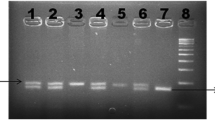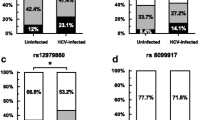Abstract
A growing body of evidence suggests that host genetic factors play an important role both in susceptibility to HIV infection and progression to AIDS. The present study aimed at evaluating the role of IL-6 and IL-10 gene polymorphisms on the risk of HIV susceptibility and disease progression among North Indian patients. The polymerase chain reaction (PCR) and restriction fragment length polymorphism (RFLP) techniques were applied to genotype IL-6 and IL-10. 300 seropositive and an equal number of age- and sex-matched seronegative control subjects were recruited for this study. There was statistically no significant variation in the frequencies of IL-6 and IL-10 genotypes among cases and controls. However, statistically non-significant association for risk of rapid disease progression was observed due to the combined effect of the IL-6 homozygous CC genotype and CC of IL-10, OR = 1.62, 95% CI = 0.38–6.91. Therefore, combined effects of the CC of IL-6 and CC of IL-10 might reduce the hosts ability to hinder viral replication after infection.




Similar content being viewed by others
References
AIDS epidemic update (2008). http://www.unaids.org. Accessed on 12 Jan 2009
Godbole S, Mehendale S (2005) HIV/AIDS epidemic in India: risk factors. Risk behaviour & strategies for prevention & control. Indian J Med Res 121:356–368
Michael NL (2002) Host genetics and HIV—removing the mask. Nat Med 8:783–785
Ward JW, Bush TJ, Perkins HA, Lieb LE, Allen JR, Goldfinger D, Samson SM, Pepkowitz SH, Fernando LP, Holland PV, Kleinman SH, Grindon AJ, Graner PA, Rutherford GW, Holmberg SD (1989) The natural history of transfusion-associated infection with human immunodeficiency virus. Factors influencing the rate of progression to disease. N Engl J Med 321:947–952
Fowke KR, Nagelkerke ND, Kimani J, Simonsen JN, Anzala AO, Bwayo JJ, McDonald KS, Ngugi EN, Plummer FA (1996) Resistance to HIV-1 infection among persistently seronegative prostitutes in Nairobi, Plummer. Lancet 348:1347–1351
Rowland-Jones SL, McMichael A (1995) Immune responses in HIV-exposed seronegatives: have they repelled the virus? Curr Opin Immunol 7:448–455
Shearer GM, Clerici M (1996) Protective immunity against HIV infection: has nature done the experiment for us? Immunol Today 17:21–24
Heeney J, Beverley P, McMichael A, Shearer G, Strominger J, Wahren B, Weber J, Gotch F (1999) Immune correlates of protection from HIV and AIDS—more answers but yet more questions. Immunol Today 20:247–251
Kulkarni PS, Butera ST, Duerr AC (2003) Resistance to HIV-1 infection: lessons learned from studies of highly exposed persistently seronegative (HEPS) individuals. AIDS Rev 5:87–103
Nowak MA, Anderson RM, McLeann AR, Wolfs TF, Goudsmit J, May RM (1991) Antigenic diversity thresholds and the development of AIDS. Science 254:963–969
Biggar RJ (1990) AIDS incubation in 1981 HIV seroconverters from different exposure groups. AIDS 4:1059–1065
Kishimoto T, Akira S, Taga T (1992) Interleukin-6 and its receptor: a paradigm for cytokines. Science 258:593–597
Pasic J, Levy WC, Sullivan MD (2003) Cytokines in depression and heart failure. Psychosom Med 65:181–193
Ramadori G, Christ B (1999) Cytokines and the hepatic acute-phase response. Semin Liver Dis 19:141–155
Fishman D, Faulds G, Jeffery R, Mohamed-Ali V, Yudkin JS, Humphries S, Woo P (1998) The effect of novel polymorphisms in the interleukin-6 (IL-6) gene on IL-6 transcription and plasma IL-6 levels, and an association with systemic-onset juvenile chronic arthritis. J Clin Invest 102:1369–1376
McNicholl JM, Smith DK, Qari SH, Hodge T (1997) Host genes and HIV: the role of the chemokine receptor gene CCR5 and its allele. Emerg Infect Dis 3:3261–3271
O’Brien SJ, Dean M (1997) In search of AIDS-resistance genes. Sci Am 277:44–51
Mocellin S, Marincola FM, Young HA (2005) Interleukin-10 and the immune response against cancer: a counterpoint. J Leukoc Biol 78:1043–1105
Del Prete G, De Carli M, Almerigogna F, Giudizi MG, Biagiotti R, Romagnani S (1993) Human IL-10 is produced by both type 1 helper (Th1) and type 2 helper (Th2) T cell clones and inhibits their antigen-specific proliferation and cytokine production. J Immunol 150:353–360
Westendorp RG, Langermans JA, Huizinga TW, Verweij CL, Sturk A (1997) Genetic influence on cytokine production in meningococcal disease. Lancet 349:1912–1913
Eskdale J, Keijsers V, Huizinga T, Gallagher G (1999) Microsatellite alleles and single nucleotide polymorphisms (SNP) combine to form four major haplotype families at the human interleukin-10 (IL-10) locus. Genes Immun 1:151–155
Langsenlehner U, Krippl P, Renner W, Yazdani-Biuki B, Eder T, Köppel H, Wascher TC, Paulweber B, Samonigg H (2005) Interleukin-10 promoter polymorphism is associated with decreased breast cancer risk. Breast Cancer Res Treat 90:113–115
De Michele A, Martin AM, Mick R, Gor P, Wray L, Klein-Cabral M, Athanasiadis G, Colligan T, Stadtmauer E, Weber B (2003) Interleukin-6–174G→C polymorphism is associated with improved outcome in high-risk breast cancer. Cancer Res 63:8051–8056
Humphries SE, Luong LA, Ogg MS, Hawe E, Miller GJ (2001) The interleukin-6-174 G/C promoter polymorphism is associated with risk of coronary heart disease and systolic blood pressure in healthy men. Eur Heart J 22:2243–2252
Cavet J, Dickinson AM, Norden J, Taylor PR, Jackson GH, Middleton PG (2001) Interferon-γ and interleukin-6 gene polymorphisms associate with graft-versus host disease in HLA-matched sibling bone marrow transplantation. Blood 98:1594–1600
Hulkkonen J, Pertovaara M, Antonen J, Pasternack A, Hurme M (2001) Elevated interleukin-6 plasma levels are regulated by the promoter region polymorphism of the IL6 gene in primary Sjogren’s syndrome and correlate with the clinical manifestations of the disease. Rheumatology 40:656–661
Pecoits-Filho R, Lindholm B, Axelsson J, Stenvinkel P (2003) Update on interleukin-6 and its role in chronic renal failure. Nephrol Dial Transplant 18:1042–1045
Bologa RM, Levine DM, Parker TS, Cheigh JS, Serur D, Stenzel KH, Rubin AL (1998) Interleukin-6 predicts hypoalbuminemia, hypocholesterolemia, and mortality in hemodialysis patients. Am J Kidney Dis 32:107–114
Cox ED, Hoffmann SC, DiMercurio BS, Wesley RA, Harlan DM, Kirk AD, Blair PJ (2001) Cytokine polymorphic analyses indicate ethnic differences in the allelic distribution of interleukin-2 and interleukin-6. Transplantation 72:720–772
Terry CF, Loukaci V, Green FR (2000) Cooperative influence of genetic polymorphisms on interleukin 6 transcriptional regulation. J Biol Chem 275:18138–18144
Vickers MA, Green FR, Terry C, Mayosi BM, Julier C, Lathrop M, Ratcliffe PJ, Watkins HC, Keavney B (2002) Genotype at a promoter polymorphism of the interleukin-6 gene is associated with baseline levels of plasma C-reactive protein. Cardiovasc Res 53:1029–1034
Matsuda M, Salazar F, Petersson M, Masucci G, Hansson J, Pisa P, Zhang QJ, Masucci MG, Kiessling R (1994) Interleukin 10 pretreatment protects target cells from tumor- and allospecific cytotoxic T cells and downregulates HLA class I expression. J Exp Med 120:2371–2376
Fortis C, Foppoli M, Gianotti L, Galli L, Citterio G, Consogno G, Gentilini O, Bragaet M (1996) Increased interleukin-10 serum levels in patients with solid tumours. Cancer Lett 104:1–5
Zhang X, Hei P, Deng L, Lin J (2007) Interleukin-10 gene promoter polymorphisms and their protein production in peritoneal fluid in patients with endometriosis. Mole Hum Reprod 13:135–140
Turner DM, Williams DM, Sankaran D, Lazarus M, Sinnott PJ, Hutchinson IV (1998) An investigation of polymorphism in the interleukin-10 gene promoter. Eur J Immunogenet 24:1–8
van der Poll T, Marchant A, Koeogh CV, Goldman M, Lowry SF (1996) Interleukin-10 impairs host defense in murine pneumococcal pneumonia. J Infect Dis 174:994–1000
Greenberger MJ, Strieter RM, Kunkel SL, Danforth JM, Goodman RE, Standiford TJ (1995) Neutralization of IL-10 increases survival in a murine model of Klebsiella pneumonia. J Immunol 155:722–729
Ku¨hn R, Lohler J, Rennick D, Rajewsky K, Muller W (1993) Interleukin-10-deficient mice develop chronic enterocolitis. Cell 75:263–274
Opal SM, De Pa VA (2000) Anti-inflammatory cytokines. Chest 117:1162–1172
Baier RJ, Loggins J, Yanamandra K (2006) IL-10, IL-6 and CD14 polymorphisms and sepsis outcome in ventilated very low birth weight infants. BMC Med 4:1–11
De Waal Malefyt R, Abrams J, Bennett B, Figdor CG, De Vries JE (1991) Interleukin 10 (IL-10) inhibits cytokine synthesis by human monocytes: an autoregulatory role of IL-10 produced by monocytes. J Exp Med 174:1209–1220
Murray PJ, Wang L, Onufryk C, Tepper RI, Young RA (1997) T cell-derived IL-10 antagonizes macrophage function in mycobacterial infection. J Immunol 158:15–21
Llorente L, Richaud-Patin Y, Fior R, Alcocer-Varela J, Wijdenes J, Fourrier BM, Galanaud P, Emilie D (1994) In vivo production of interleukin-10 by non-T cells in rheumatoid arthritis, Sjogren’s syndrome, and systemic lupus erythematosus. A potential mechanism of B lymphocyte hyperactivity and autoimmunity. Arthr Rheum 37:1647–1655
Mason D, Powrie F (1998) Control of immune pathology by regulatory T cells. Curr Opin Immunol 10:649–655
Kim J, Modlin RL, Moy RL, Dubinett SM, McHugh T, Nickoloff BJ, Uyemura K (1995) IL-10 production in cutaneous basal and squamous cell carcinomas. A mechanism for evading the local T cell immune response. J Immunol 155:2240
Miller LC, Lynch EA, Isa S, Logan JW, Dinarello CA, Steere AC (1993) Balance of synovial fluid IL-1 beta and IL-1 receptor antagonist and recovery from lyme arthritis. Lancet 341:146–148
Girardin E, Roux-Lombard P, Grau GE, Suter P, Gallati H (1992) Imbalance between tumor necrosis factor alpha and soluble TNF receptor levels in severe meningococcemia. Immunology 76:20–23
Villard J, Roux-Lombard P, Hugli A, Dayer JM (1993) Could natural inhibitors of tumor necrosis factor alpha modify the clinical course of fulminant meningococcemia? Critical Care Med 21:1396–1400
Spear GT, MEAF A, Cohen MH, Bremer J, Landay AL (2005) Relationship of HIV RNA and cytokines in saliva from HIV-infected individuals. FEMS Immunol Med Microbiol 45:129–136
Scriba TJ, Zhang HT, Brown HL, Oxenius A, Tamm N, Fidler S, Fox J, Weber JN, Klenerman P, Day CL, Lucas M, Phillips RE (2005) HIV-1—specific CD4+ T lymphocyte turnover and activation increase upon viral rebound. J Clin Invest 115:443–450
Acknowledgment
The authors of this paper are thankful to Dr. Ajay Wanchu’s clinical staff for the kind help and assistance they have provided during sample collection and data recording.
Author information
Authors and Affiliations
Corresponding author
Rights and permissions
About this article
Cite this article
Sobti, R.C., Berhane, N., Mahedi, S.A. et al. Polymorphisms of IL-6 174 G/C, IL-10 -592 C/A and risk of HIV/AIDS among North Indian population. Mol Cell Biochem 337, 145–152 (2010). https://doi.org/10.1007/s11010-009-0293-0
Received:
Accepted:
Published:
Issue Date:
DOI: https://doi.org/10.1007/s11010-009-0293-0




